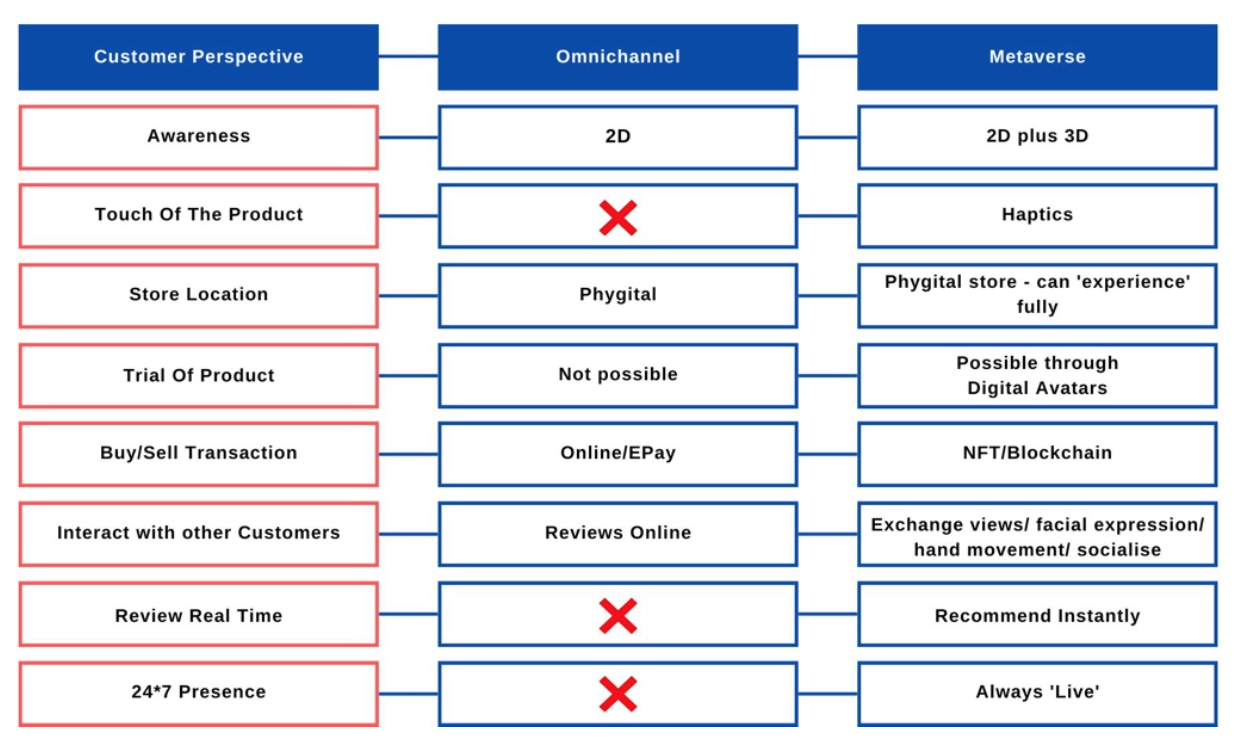California Management Review
California Management Review is a premier professional management journal for practitioners published at UC Berkeley Haas School of Business.
by Sanchit Misra, Shibashish Chakraborty, and Rajeshwari Krishnamurthy

Image Credit | the blowup
“A Brief History of Artificial Intelligence: On the Past, Present, and Future of Artificial Intelligence” by Michael Haenlein & Andreas Kaplan. (Vol. 61/4) 2019.
Omnichannel aims to provide customers with a seamless and integrated shopping experience across all channels, including online, mobile, in-store, and social media.1 Omnichannel’s advantages include:
However, omnichannel operates largely on a 2D format, thus limiting the richness and interactivity.2 Metaverse, on the other hand, is a 3D internet virtual phenomenon that is being explored as a new retail distribution platform. Here the retailers can create virtual stores and showcase their products to customers in a visually immersive and interactive way. There is no limitation on either the customer reach or the physical geography on Metaverse. Retailers can obtain valuable data and insights about customer behavior, which can be used to design future product offerings and marketing strategies. However, the concept of the Metaverse is still in its early stages, and its potential impact on the retail industry remains to be seen.3
Metaverse, as a decentralized and immersive platform, has the potential to fill several gaps in Omnichannel Retail.4 Some of these are:
Omnichannel picks up customer data from several places but these remain fragmented, thus not enabling coherent and meaningful analysis.
Metaverse has the potential to provide a unified customer identity by using blockchain technology to create a decentralized digital identity for each customer. This identity can be used across multiple channels to store all the relevant customer data, such as purchase history, preferences, and demographics, in a secure and centralized location.5 Through this, retailers can provide a more personalized and cohesive customer experience. For example, suppose a customer makes a purchase online and later visits a physical store; the retailer can now use their digital identity to recognize them, access their purchase history, and offer relevant recommendations based on their preferences.6 Additionally, having a centralized system for storing customer data can result in better data management, thus improving infrastructure efficiency.7
In conclusion, Metaverse’s ability to provide a unified customer identity can significantly enhance the omnichannel retail experience by improving the cohesiveness of customer interactions and facilitating better data management- all resulting in an enhanced customer experience and operational efficiency.8
In the absence of cohesive customer data, omnichannels are unable to create personalized storefronts. Metaverse promises to fulfill this gap and enables retailers to craft customized virtual shopping ambience that reflects their brand and product offerings. They can also use virtual reality (VR) technology to create immersive customer experiences, such as virtual product demonstrations or try-before-you-buy scenarios. Some examples include - Nike has used Metaverse technology to create a virtual store called Nike Rise, which allows customers to explore and shop for products in a personalized, gamified experience. The store features virtual coaches, personalized workout plans, and rewards for completing challenges. IKEA has developed a Metaverse experience called “IKEA VR Experience,” which allows customers to explore and interact with virtual versions of the brand’s furniture and home decor products. Customers can customize the colors and materials of products, visualize them in their own homes, and even take virtual tours of IKEA stores.
Additionally, Metaverse virtual environments can be accessed in real-time, allowing a 24/7 interaction. These facilitate faster decision making, and timely product scheme/ offers’ adoption, thus optimizing the retail experience.9
The limitation of geographical location has also been taken away by the Metaverse. Now customers can sit in the comfort of their homes, touch and feel the products using haptics (extended arm experience) and complete the trial and transaction.10
In conclusion, Metaverse offers an immersive personal experience that is not limited by geographical location, time or physical touch.
Metaverse has the potential to improve supply chain management by using decentralized ledger technology to track and record transactions and product movements in real time.11 This creates a transparent and auditable record of all actions, improving efficiency and reducing the risk of fraud or errors. Unlike Omnichannel Retail, where the tracking and monitoring of products may be fragmented across different systems, in Metaverse, all the information is stored in a shared and accessible database, enabling all stakeholders to have up-to-date information on the movement and status of products, which leads to improved collaboration and coordination.12
One limitation of omnichannel e-commerce is insufficient trust in dealings due to inconsistencies in product information and customer service across different channels. Metaverse has the potential to use blockchain technology to establish a secure and transparent transaction system for e-commerce. Using decentralized ledger technology, all transactions are recorded in a tamper-proof and immutable way, providing a verifiable history of all activities. This helps increase trust in e-commerce transactions, as it ensures that the transaction details cannot be altered or deleted and all parties have access to the same information. In comparison, in Omnichannel Retail, transaction details may be stored in siloed systems, making it harder to establish a complete and accurate picture of all transactions, leading to reduced trust. Thus, Metaverse is a superior way to conduct transactions with greater confidence and security.13
Omnichannel is seldom seamless across channels. Metaverse scores here as it has the potential to bridge the gap between physical and digital retail experiences by the use of advanced technologies such as virtual and augmented reality. Additionally, these virtual storefronts can be accessed from anywhere, anytime, providing customers with the convenience and accessibility of online shopping while offering the immersive and interactive elements of in-store shopping.14 Thus Metaverse has the potential to provide a seamless shopping experience that combines the benefits of both physical and digital retail, bridging the gap between the two.12
In conclusion, the Metaverse presents a promising new frontier for retail distribution, over and above the Omnichannel experience. (Figure 1) Its success depends on the organization’s and consumers’ technology adoption and the retailers’ ability to effectively utilize it.15 Businesses will do well to embrace Metaverse in order to increase their competitiveness in the market place, in order to stay more connected with their customers.

Figure 1: How does Metaverse extend the Omnichannel experience?
Piotrowicz, Wojciech, and Richard Cuthbertson. “Introduction to the special issue information technology in retail: Toward omnichannel retailing.” International Journal of Electronic Commerce 18.4 (2014): 5-16.
Li, Hairong, Terry Daugherty, and Frank Biocca. “Characteristics of virtual experience in electronic commerce: A protocol analysis.” Journal of interactive Marketing 15.3 (2001): 13-30.
Bourlakis, Michael, Savvas Papagiannidis, and Feng Li. “Retail spatial evolution: paving the way from traditional to metaverse retailing.” Electronic Commerce Research 9 (2009): 135-148.
Krishnamurthy, Rajeshwari, et al. “Transforming Your Brand Using the Metaverse: Eight Strategic Elements to Plan For.”
Vázquez Rico, Sara. “Banking and fintech in the customer experience era.” (2022).
Gonzales Sepulveda, Marielisa. “What is the metaverse and how is it shaping the future of marketing; the role of cultural codes in virtual experiences: a cross cultural case study.” (2022).
Shan, Richard, and Tony Shan. “Digital Transformation Method for Healthcare Data.” Big Data–BigData 2021: 10th International Conference, Held as Part of the Services Conference Federation, SCF 2021, Virtual Event, December 10–14, 2021, Proceedings. Cham: Springer International Publishing, 2022.
Miell, Sophie L. Enabling the digital fashion consumer through gamified fit and sizing experience technologies. The University of Manchester (United Kingdom), 2018.
Dwivedi, Yogesh K., et al. “Metaverse beyond the hype: Multidisciplinary perspectives on emerging challenges, opportunities, and agenda for research, practice and policy.” International Journal of Information Management 66 (2022): 102542.
Xu, Minrui, et al. “A full dive into realizing the edge-enabled metaverse: Visions, enabling technologies, and challenges.” IEEE Communications Surveys & Tutorials (2022).
Gadekallu, Thippa Reddy, et al. “Blockchain for the metaverse: A review.” arXiv preprint arXiv:2203.09738 (2022).
Dwivedi, Yogesh K., et al. “Metaverse marketing: How the metaverse will shape the future of consumer research and practice.” Psychology & Marketing (2022).
Alkhudary, Rami, Bertrand Belvaux, and Nathalie Guibert. “Understanding non-fungible tokens (NFTs): insights on consumption practices and a research agenda.” Marketing Letters (2022): 1-16.
Haenlein, Michael, and Andreas Kaplan. “A brief history of artificial intelligence: On the past, present, and future of artificial intelligence.” California management review 61.4 (2019): 5-14.
Breiter, Dennis, and Patrick Siegfried. “The Metaverse: Exploring Consumer’s Expectations, Their Attitudes, and it’s Mean-ing to the Fashion Industry.” Breiter, D./Siegfried, P.(2022): The Metaverse: Exploring consumer’s expectations, their attitudes, and it’s meaning to the fashion industry, eISSN (2022): 2683-5665.